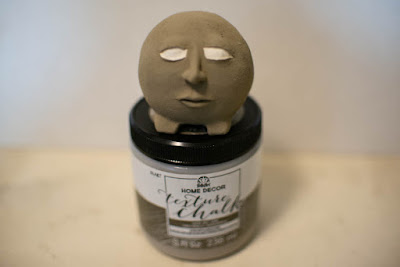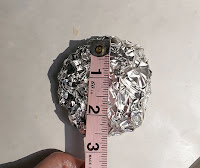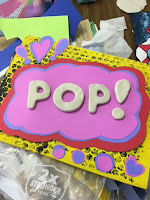Here is what you'll need!
- Creative Paperclay®
- Scissors
- Rocks
- Newspaper
- Masking tape
- Sand paper
- Acrylic paint
- Aleene's Tacky glue
- Lambs wool (or synthetic hair from the hair shop)
- Felting needle (Optional)
- Wool felt sheet (Optional)
First I start off by making a ball out of newspaper and putting something heavy like rocks in the center.
I wrapped it with masking tape to get it to hold its shape and put a coating of gesso on top. As I've said in my previous tutorials, the gesso just makes it a bit easier for the paper clay to adhere to the masking tape. You can totally add the clay to the tape without it, but it will be a bit more of a struggle.
Here you can start bulking up the piece with paperclay. Allow the piece to dry and sand it to the level of smoothness that you are happy with.
At this stage I added little nubs to the bottom of the piece so that it becomes stationary and doesn't roll around.
Paperclay shrinks a bit when it dries, so be sure to check the nubs to see that both sides dried evenly and that the piece isn't wobbly. You may have to add a bit more clay to one side so that the piece is stable as I had to go back and do. Allow the nubs to dry and sand them down as well.
Once the piece is stable, you can begin to work on the face. Here I started plotting with pencil where I wanted the eyes nose and mouth to go. I normally skip this step and work free style, but I would totally recommend doing this for those who are not comfortable working without guides, or those who are just learning.
On this piece, I was fortunate enough to be able to try out FolkArt's ® Home Decor ® Texture Chalk™, which was sent over to me from PLAID. It has a nice gritty and chalky texture, so I ended up not covering this piece with varnish as I usually do out of fear that it would ruin the look of it. The color is Wet Sand that I am using here.
The paint gave the piece a nice and rough texture, and since it was so thick I ended up using just one coat which saved me a lot of time! Bonus points there!
Ok so this step is completely optional since I have a new obsession with needle felting and already had some Leicester Longwool strands and wool felt sitting around in the studio. If you are unfamiliar with needle felting and are curious about it, please head on over to Youtube to see some videos on it. It's really easy to do, for the most part you are just stabbing wool with a needle until the shape that you are trying to get begins to form. It's kind of therapeutic, but that is a whole lesson within itself! Anywho, I made this hat and partial wig using that method and glued them on with Aleene's Tacky Glue. You can make something similar with good old fashioned glue or a needle and thread!
Thank you for stopping by and be sure to look for some Creative Paperclay® in your local craft store and also on these sites I listed below! I hope you all enjoyed this tutorial and come back on the fourth Friday next month for my next creation!





































































